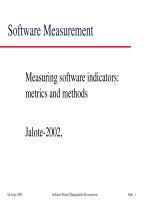PHÁT TRIỂN VẬN HÀNH BẢO TRÌ PHẦN MỀM - Chương 3: QUI TRÌNH VÀ MÔ HÌNH BẢO TRÌ PHẦN MỀM pptx
Bạn đang xem bản rút gọn của tài liệu. Xem và tải ngay bản đầy đủ của tài liệu tại đây (1.04 MB, 50 trang )
1
UIT-VNUHCM 2009
PHÁT TRIỂN VẬN HÀNH BẢO
TRÌ PHẦN MỀM
ThS. NGUYỄN THỊ THANH TRÚC
TRƯỜNG ĐẠI HỌC CÔNG NGHỆ THÔNG TIN
KHOA CÔNG NGHỆ PHẦN MỀM
2
UIT-VNUHCM 2009
Company Logo
Nội dung (Chương 3)
Q&A
Thảo luận và làm bài tập
KHI THỰC HiỆN THAY ĐỔI
CÁC MÔ HÌNH BẢO TRÌ PHẦN MỀM
QUI TRÌNH BẢO TRÌ PHẦN MỀM
3
UIT-VNUHCM 2009
Chương 3:
QUI TRÌNH VÀ MÔ HÌNH BẢO TRÌ PHẦN
MỀM
3.1 QUI TRÌNH BẢO TRÌ PHẦN MỀM
3.2 CÁC MÔ HÌNH BẢO TRÌ PHẦN MỀM
3.3 KHI THỰC HiỆN THAY ĐỔI
4
UIT-VNUHCM 2009
Chương 3:
QUI TRÌNH VÀ MÔ HÌNH BẢO TRÌ PHẦN MỀM
1. QUI TRÌNH BẢO TRÌ PHẦN MỀM
o
Định nghĩa
o
Qui trình sản phẩm phần mềm
o
Đánh giá phê bình qui trình mô hình truyền thống
Code-and-Fix Model
Waterfall Model
Spiral Model
2. CÁC MÔ HÌNH BẢO TRÌ PHẦN MỀM
o
Mô hình Quick-Fix
o
Mô hình Boehm
o
Mô hình Osborne
o
Iterative Enhancement Model
o
Mô hình Reuse-Oriented
3. KHI THỰC HiỆN THAY ĐỔI
o
Tăng trưởng qui trình
o
Mô hình tăng trưởng CMM (Capability Maturity Model) cho phần mềm
o
Cơ sở kinh nghiệm phần mềm
5
UIT-VNUHCM 2009
3.1 QUI TRÌNH BẢO TRÌ PHẦN MỀM
Định nghĩa
Qui trình sản phẩm phần mềm
Đánh giá phê bình qui trình mô hình truyền thống
o
Code-and-Fix Model
o
Waterfall Model
o
Spiral Model
6
UIT-VNUHCM 2009
Software Process
Fundamental Assumption:
Good processes lead to good software
Good processes reduce risk
Good processes enhance visibility
7
UIT-VNUHCM 2009
Basic Process Steps in all Software Development
• Feasibility and planning
• Requirements
• System and program design
• Implementation and testing
• Acceptance testing and release
• Operation and maintenance
It is essential to distinguish among these process steps and to be
clear which you are are doing at any given moment.
Do not confuse requirements and design
8
UIT-VNUHCM 2009
Sequence of Processes (software lifecycle)
Every software project will include these basic processes, in some
shape or form, but they may be carried out in various sequences
Major alternatives
• Sequential: Complete each process step before beginning the
next (but see the next few slides). Waterfall model.
• Iterative: Go quickly through all process steps to create a
rough system, then repeat them to improve the system. Iterative
refinement.
9
UIT-VNUHCM 2009
Sequential Development:
The Waterfall Model
Requirements
System design
Testing
Operation & maintenance
Program design
Implementation (coding)
Acceptance & release
Requirements
Design
Implementation
Feasibility study
10
UIT-VNUHCM 2009
Thảo luận Waterfall Model
Thuận lợi:
• Process visibility
• Separation of tasks
• Quality control at each step
• Cost monitoring at each step
Không thuận lợi:
Each stage in the process reveals new understanding of the
previous stages, that often requires the earlier stages to be
revised.
The Waterfall Model is not enough!
11
UIT-VNUHCM 2009
Tính tuần tự của các qui trình
Mô hình thuần tuần tự thì không thể
Ví dụ:
• Nghiên cứu khả thi không thể tạo ngân sách dự trù và lịch biểu
mà không có nghiên cứu sơ bộ những yêu cầu và thiết kế thăm
dò
• Thiết kế chi tiết hay thực thi thường bộc lộ kẽ hơ trong đặc tả
yêu cầu.
Kế hoạch phải được cho phép cho những hình thành từ bước
lặp.
12
UIT-VNUHCM 2009
Modified Waterfall Model-1
Requirements
System design
Testing
Operation & maintenance
Program design
Implementation (coding)
Acceptance & release
Waterfall model
with feedback
This is better
Feasibility study
13
UIT-VNUHCM 2009
Modified Waterfall Model-2
Feasibility study
Test
Software
Requirements
Test
System design
Design
Test
Program design
Design
Test
Implementation
Test
Experimentation
Debugging
Test
Acceptance
Maintenance
Test
14
UIT-VNUHCM 2009
Iterative/spiral Refinement
Concept: Initial implementation for client and
user comment, followed by refinement until
system is complete
Requirements
Design
Implementation
Evaluation
15
UIT-VNUHCM 2009
The Spiral Process
time
1
Requirements
analysis
Design
Implementation
Evaluation
1Iteration #
1
1
2
2
2
3
3
3
Product released X
M I L E S T O N E S
2 3
2
3
1
Intermediate version
(prototype) X
Intermediate version
(2
nd
prototype) X
16
UIT-VNUHCM 2009
Mô hình Life-Cycle khác
Build-and-fix model
Rapid prototyping model
Incremental model
Extreme programming
Component-based software engineering
Mô hình đồng bộ hoá và ổn định
(Synchronize-and-stabilize) model
Object-oriented life-cycle models
17
UIT-VNUHCM 2009
1-Build and Fix Model
18
UIT-VNUHCM 2009
Lưu ý
Hầu hết phần mềm được phát triển dùng
mô hình build-and-fix model. Cơ bản là
không có mô hình.
o
Không đặc tả
o
Không thiết kế
Mô hình này hoàn toàn không thoả mãn và
không nên được chấp nhận.
19
UIT-VNUHCM 2009
3-Incremental development advantages
Customer value can be delivered with each
increment so system functionality is available
earlier.
Early increments act as a prototype to help elicit
requirements for later increments.
Lower risk of overall project failure.
The highest priority system services tend to
receive the most testing.
20
UIT-VNUHCM 2009
analysis
design code test
System/information
engineering
analysis
design code test
analysis
design code test
analysis
design code test
Bản tăng 2
Chuyền giao
bản tăng 4
Thêi gian
Bản tăng 3
Bản tăng 1
Bản tăng 4
Chuyền giao
bản tăng 1
Chuyền giao
bản tăng 2
Chuyền giao
bản tăng 3
MÔ HÌNH PHÁT TRIỂN TĂNG TRƯỞNG
21
UIT-VNUHCM 2009
HOẠT ĐỘNG PHÁT TRIỂN TĂNG TRƯỞNG
Xác định yêu cầu
tổng thể
Gán yêu cầu cho
các bản tăng
Thiết kế
kiến trúc
Phát triển
bản tăng
Tích hợp
bản tăng
Kiểm thử
hệ thống
Hệ thống chưa hoàn thành
Hệ thống
cuối cùng
22
UIT-VNUHCM 2009
4-Extreme Programming (XP)
Là một điển hình qui trình Agile
Appropriate for environments with:
o
Nhóm nhỏ
o
Yêu cầu thay đổi nhanh
Một số nguyên lý XP đặc nền tảng trên:
o
Small Releases – Phần mềm đã phát triển trong những giai đoạn
đã được cập nhật thường xuyên
o
Simple Design – Hiện thực code cần đạt kết quả khách hàng
mong đợi khôg nhấn mạnh đến version tương lai
o
Testing – Hoàn tất qua toàn bộ qui trình phát triển. Kiểm thử là
thiết kế đầu tiên trước khi viết phần mềm
23
UIT-VNUHCM 2009
Component-based software engineering
Based on systematic reuse where systems are
integrated from existing components or COTS
(Commercial-off-the-shelf) systems.
Các giai đoan qui trình
o
Component analysis;
o
Requirements modification;
o
System design with reuse;
o
Development and integration.
This approach is becoming increasingly used as
component standards have emerged.
24
UIT-VNUHCM 2009
Reuse-oriented development
Requirements
specifi cation
Component
analysis
Development
and integ ration
System design
with reuse
Requi rements
modification
System
validation
25
UIT-VNUHCM 2009
Các tiếp cận để phát triển phần mềm
Traditional systems development life cycle
Prototyping
Packaged software
End-user development
Outsourcing
Open source
Thảo luận Thuận lợi và Bất lợi các tiếp cận trên









